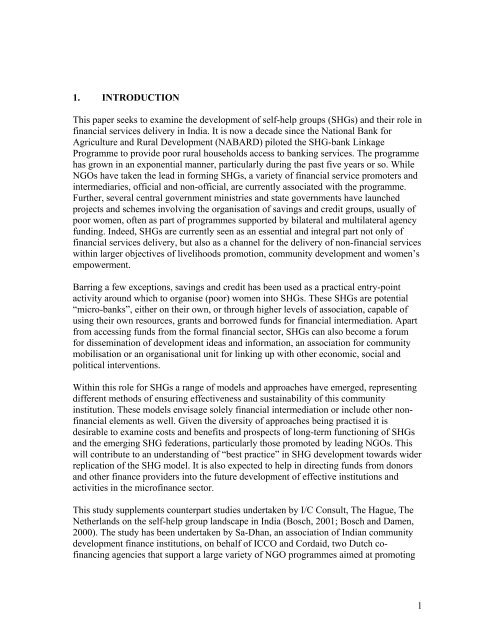Self-help Groups as Financial Intermediaries in India ... - Sa-Dhan
Self-help Groups as Financial Intermediaries in India ... - Sa-Dhan
Self-help Groups as Financial Intermediaries in India ... - Sa-Dhan
You also want an ePaper? Increase the reach of your titles
YUMPU automatically turns print PDFs into web optimized ePapers that Google loves.
1. INTRODUCTIONThis paper seeks to exam<strong>in</strong>e the development of self-<strong>help</strong> groups (SHGs) and their role <strong>in</strong>f<strong>in</strong>ancial services delivery <strong>in</strong> <strong>India</strong>. It is now a decade s<strong>in</strong>ce the National Bank forAgriculture and Rural Development (NABARD) piloted the SHG-bank L<strong>in</strong>kageProgramme to provide poor rural households access to bank<strong>in</strong>g services. The programmeh<strong>as</strong> grown <strong>in</strong> an exponential manner, particularly dur<strong>in</strong>g the p<strong>as</strong>t five years or so. WhileNGOs have taken the lead <strong>in</strong> form<strong>in</strong>g SHGs, a variety of f<strong>in</strong>ancial service promoters and<strong>in</strong>termediaries, official and non-official, are currently <strong>as</strong>sociated with the programme.Further, several central government m<strong>in</strong>istries and state governments have launchedprojects and schemes <strong>in</strong>volv<strong>in</strong>g the organisation of sav<strong>in</strong>gs and credit groups, usually ofpoor women, often <strong>as</strong> part of programmes supported by bilateral and multilateral agencyfund<strong>in</strong>g. Indeed, SHGs are currently seen <strong>as</strong> an essential and <strong>in</strong>tegral part not only off<strong>in</strong>ancial services delivery, but also <strong>as</strong> a channel for the delivery of non-f<strong>in</strong>ancial serviceswith<strong>in</strong> larger objectives of livelihoods promotion, community development and women’sempowerment.Barr<strong>in</strong>g a few exceptions, sav<strong>in</strong>gs and credit h<strong>as</strong> been used <strong>as</strong> a practical entry-po<strong>in</strong>tactivity around which to organise (poor) women <strong>in</strong>to SHGs. These SHGs are potential“micro-banks”, either on their own, or through higher levels of <strong>as</strong>sociation, capable ofus<strong>in</strong>g their own resources, grants and borrowed funds for f<strong>in</strong>ancial <strong>in</strong>termediation. Apartfrom access<strong>in</strong>g funds from the formal f<strong>in</strong>ancial sector, SHGs can also become a forumfor dissem<strong>in</strong>ation of development ide<strong>as</strong> and <strong>in</strong>formation, an <strong>as</strong>sociation for communitymobilisation or an organisational unit for l<strong>in</strong>k<strong>in</strong>g up with other economic, social andpolitical <strong>in</strong>terventions.With<strong>in</strong> this role for SHGs a range of models and approaches have emerged, represent<strong>in</strong>gdifferent methods of ensur<strong>in</strong>g effectiveness and susta<strong>in</strong>ability of this community<strong>in</strong>stitution. These models envisage solely f<strong>in</strong>ancial <strong>in</strong>termediation or <strong>in</strong>clude other nonf<strong>in</strong>ancialelements <strong>as</strong> well. Given the diversity of approaches be<strong>in</strong>g practised it isdesirable to exam<strong>in</strong>e costs and benefits and prospects of long-term function<strong>in</strong>g of SHGsand the emerg<strong>in</strong>g SHG federations, particularly those promoted by lead<strong>in</strong>g NGOs. Thiswill contribute to an understand<strong>in</strong>g of “best practice” <strong>in</strong> SHG development towards widerreplication of the SHG model. It is also expected to <strong>help</strong> <strong>in</strong> direct<strong>in</strong>g funds from donorsand other f<strong>in</strong>ance providers <strong>in</strong>to the future development of effective <strong>in</strong>stitutions andactivities <strong>in</strong> the microf<strong>in</strong>ance sector.This study supplements counterpart studies undertaken by I/C Consult, The Hague, TheNetherlands on the self-<strong>help</strong> group landscape <strong>in</strong> <strong>India</strong> (Bosch, 2001; Bosch and Damen,2000). The study h<strong>as</strong> been undertaken by <strong>Sa</strong>-<strong>Dhan</strong>, an <strong>as</strong>sociation of <strong>India</strong>n communitydevelopment f<strong>in</strong>ance <strong>in</strong>stitutions, on behalf of ICCO and Cordaid, two Dutch cof<strong>in</strong>anc<strong>in</strong>gagencies that support a large variety of NGO programmes aimed at promot<strong>in</strong>g1















